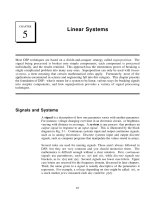Designing reactive systems
Bạn đang xem bản rút gọn của tài liệu. Xem và tải ngay bản đầy đủ của tài liệu tại đây (6.32 MB, 66 trang )
Programming
Designing Reactive Systems
The Role of Actors in Distributed Architecture
Hugh McKee
Designing Reactive Systems
by Hugh McKee
Copyright © 2017 Lightbend, Inc. All rights reserved.
Printed in the United States of America.
Published by O’Reilly Media, Inc., 1005 Gravenstein Highway North,
Sebastopol, CA 95472.
O’Reilly books may be purchased for educational, business, or sales
promotional use. Online editions are also available for most titles
( For more information, contact our
corporate/institutional sales department: 800-998-9938 or
.
Editor: Brian Foster
Production Editor: Nicholas Adams
Copyeditor: Kim Cofer
Interior Designer: David Futato
Cover Designer: Randy Comer
Illustrator: Rebecca Demarest
January 2017: First Edition
Revision History for the First Edition
2017-01-12: First Release
The O’Reilly logo is a registered trademark of O’Reilly Media, Inc.
Designing Reactive Systems, the cover image, and related trade dress are
trademarks of O’Reilly Media, Inc.
While the publisher and the author have used good faith efforts to ensure that
the information and instructions contained in this work are accurate, the
publisher and the author disclaim all responsibility for errors or omissions,
including without limitation responsibility for damages resulting from the use
of or reliance on this work. Use of the information and instructions contained
in this work is at your own risk. If any code samples or other technology this
work contains or describes is subject to open source licenses or the
intellectual property rights of others, it is your responsibility to ensure that
your use thereof complies with such licenses and/or rights.
978-1-491-97090-4
[LSI]
Chapter 1. Introduction
We are in the midst of a rapid evolution in how we build computer systems.
Applications must be highly responsive to hold the interest of users with
ever-decreasing attention spans, as well as evolve quickly to remain relevant
to meet the ever-changing needs and expectations of the audience.
At the same time, the technologies available for building applications
continue to evolve at a rapid pace (see Figure 1-1). It is now possible to
effectively utilize clusters of cores on individual servers and clusters of
servers that work together as a single application platform. Memory and disk
storage costs have dropped. Network speeds have grown significantly,
encouraging huge increases in online user activity. As a result, there has been
explosive growth in the volume of data to be accumulated, analyzed, and put
to good use.
Figure 1-1. It’s a New World
Put simply, science has evolved, and the requirements to serve the
applications built nowadays cannot rely on the approaches used over the past
10–15 years. One concept that has emerged as an effective tool for building
systems that can take advantage of the processing power harnessed by
multicore, in-memory, clustered environments is the Actor model.
Created in 1973 by noted computer scientist Carl Hewitt, the Actor model
was designed to be “unlike previous models of computation... inspired by
physics, including general relativity and quantum mechanics.”
The Actor model defines a relatively simple but powerful way for designing
and implementing applications that can distribute and share work across all
system resources — from threads and cores to clusters of servers and data
centers. The Actor model is used to provide an effective way for building
applications that perform tasks with a high level of concurrency and
increasing levels of resource efficiency. Importantly, the Actor model also
has well-defined ways for handling errors and failures gracefully, ensuring a
level of resilience that isolates issues and prevents cascading failures and
massive downtime.
One of the most powerful aspects of the Actor model is that, in many ways,
actors behave and interact very much like we humans do. Of course, how a
software actor behaves in the Actor model is much simpler than how we
interact as humans, but these similar behavioral patterns do provide some
basic intuition when designing actor-based systems.
This simplicity and intuitive behavior of the actor as a building block allows
for designing and implementing very elegant, highly efficient applications
that natively know how to heal themselves when failures occur.
Building systems with actors also has a profound impact on the overall
software engineering process. The system design and implementation
processes with actors allows architects, designers, and developers to focus
more on the core functionality of the system and focus less on the lower-level
technical details needed to successfully build and maintain distributed
systems.
“In general, application developers simply do not implement large scalable
applications assuming distributed transactions.”
Pat Helland
In the past, building systems to support high levels of concurrency typically
involved a great deal of low-level wiring and very technical programming
techniques that are difficult to master. These technical challenges drew much
of the attention away from the core business functionality of the system
because much of the effort had to be focused on the functional details.
The end result was that a considerable amount of time and effort was spent
on the plumbing and wiring, when that time could be better spent on
implementing the important functionality of the system itself. When building
systems with actors, things are done at a higher level of abstraction because
the plumbing and wiring is already built into the Actor model. Not only does
this liberate us from the gory details of traditional system implementations, it
also allows for more focus on core system functionality and innovation.
Summary
Technology adoption is rarely cyclical; however, in case of the Actor model
(created in the early 1970s) the spotlight is swinging back to this unique
approach to distributed, concurrent computation. As Forrester Research
points out in “How To Capture The Benefits Of Microservice Design”
(2016), the Actor model is receiving “renewed interest as cloud concurrency
challenges grow” in enterprises building microservices architectures.
This report is targeted toward decision makers in the enterprise and provides
some high-level insight into how actors and actor systems can be used to
create lightweight business systems that evolve quickly, that can scale, and
that can run without stopping. Inside, you’ll read how the Actor model’s
proven approach to concurrent computation is the best way to build
distributed systems correctly from the start, allowing your teams to focus on
the business logic of your applications instead of wiring together low-level
protocols, in turn helping you accelerate time-to-market while keeping
infrastructure costs low.
Chapter 2. Actors, Humans, and
How We Live
Imagine a world where most people are glued to small, hand-held devices
that let them send messages to other humans across oceans and continents...
wait, we already live in this world!
With actors, it is much the same. The only way to contact a software actor is
to send it a message, much like how we exchange text messages on mobile
devices. As an example, consider a typical text message exchange between
you and a friend. While commuting to work you text your friend and say
“Good morning” (see Figure 2-1).
Figure 2-1. Actor messages are like text messages
After you send your friend a message and before she responds, you are free to
do other things, such as sending text messages to other friends. It’s
conceivable that you would also receive requests via text messages to
perform other tasks, which may send you off to do other things and interact
with other people.
Your friend may quickly see the message, and responds “Hello, how R U
today?” (see Figure 2-2).
Figure 2-2. Actors behave like humans exchanging text messages
This is basically how messages between software actors behave. When an
actor sends a message to another actor, it does not wait for a response; it is
free to do other things, such as send messages to other actors.
When you send a text message to a friend or colleague there are a number of
possible outcomes. The typical expected outcome is that a short time later
you get a response message from your friend. Another possible outcome is
that you never get a response to your message.
If you expect a response and never get one (see Figure 2-3), you might wait
for a while and then try to send her another text message (see Figure 2-4).
In between getting a quick response and no response is the possibility of
getting a response after you are unable to or uninterested in continuing the
conversation, because your attention is focused elsewhere. In this example
texting conversation scenario, you still do not get a response.
Figure 2-3. No response to your text, what do you do?
Figure 2-4. No response to a text, send another text
At this point you may be getting somewhat concerned (see Figure 2-5). You
expected your friend to respond, and now you are unable to get in touch with
her. So what do you do next? This is where you may have to consider your
options, such as:
Wait some more and try to message her again
Call your friend by phone
Get in touch with someone else that may know the status of your friend
Figure 2-5. Still no response
To be fair, there is a fourth option: stand still and do nothing until you hear
from your friend. Blocking all activities until a response is received is
probably not considered a feasible thing for most humans, and would make
for a pretty inefficient world; yet in many traditional systems, this is precisely
what happens, and why the Actor model was created.
Just as with humans sending text messages, actors that can send and receive
messages are prepared for multiple possible outcomes: a response may be
received quickly, there may be no response at all, or there may be a response
that is too late to be useful. The point here is that the actor may be
implemented to handle one or more of these possible outcomes.
A well-defined actor can not only handle a typical expected message
exchange, it may be capable of handling the other possible outcomes. For
example, Actor A sends a message to Actor B. The message is a request to B
to perform a specific task.
The desired outcome is for B to perform the task and then send a response
message back to A (see Figure 2-6). There is a possibility that B is unable to
perform the request task and, as a result, A never gets a response (see
Figure 2-7). A is prepared for this and has a plan to handle not getting a
response.
Figure 2-6. Actor A sends a message to B and later gets the expected response
Figure 2-7. Actor B never responds to message from A
A common approach for handling a no-response scenario is for the actor to
send a request to another actor to perform a task, setting up a timeout
message to be sent to itself at some point in the future. If A asks B to perform
a task and B responds back to A before the timeout message arrives, then all
is well and A cancels the timeout message (see Figure 2-8).
Figure 2-8. Actor A sends message to B and it responds before the timeout
On the other hand, if the timeout message arrives, this triggers A to switch to
an alternate plan. How it handles this alternate scenario is very specific to
each actor. In some cases, Actor A may simply resend the message to Actor
B. In other cases, Actor A may give up and report an error back upstream to
the sender of the message that triggered A in the first place (see Figure 2-9).
Figure 2-9. No response from Actor B and A gets timeout message
The key point here is that actors exchange messages with each other to
communicate. These messages are sent asynchronously, very much in the
way humans exchange text messages. Due to this asynchronous behavior,
actors are designed not only for the expected happy path, they are also
designed and implemented to handle the unhappy path. In the Actor model,
failure handling and recovery is an architectural feature, and not treated as an
afterthought.
Actor Supervisors and Workers
Actors may create other actors. When one actor creates another actor, the
creator is known as the supervisor and the created actor is known as the
worker. Worker actors may be created for many reasons, but among the most
common reasons is for delegating work. The supervisor creates one or more
worker actors and delegates work to them (see Figure 2-10).
Figure 2-10. Supervisor actor creates worker actors
The supervisor also becomes a caretaker of the workers. Just as with a parent
watching over the well-being of their children, the supervisor watches out for
the well-being of its workers. If a worker runs into a problem, it suspends
itself and notifies its supervisor of the failure (Figure 2-11).
Figure 2-11. Worker actor has problem and notifies its supervisor
When the supervisor is notified it determines what should be done to handle
the problem and how to get the worker actor back into a healthy state (see
Figure 2-12).
Figure 2-12. Supervisor fixes worker that has experienced a problem
Because the supervisor can send messages asynchronously, without having to
wait for a response, the supervisor may send messages to each of its workers,
which run independently and concurrently. This is in contrast to the
traditional sequential programming model.
Let’s consider a scenario where a supervisor actor receives a message to
perform a task. In order for the supervisor to complete this request, it must
complete three subtasks (see Figure 2-13):
Obtain the customer profile
Pull recent customer activity
Calculate customer-specific sales opportunities
The supervisor delegates this work to three worker actors. The individual
actors used are specifically designed to handle the individual tasks, so that
one actor knows how to get a customer’s profile and the other two actors are
each designed to pull recent activity and calculate sales opportunities.
Figure 2-13. Supervisor actor delegates tasks to worker actors
The supervisor sends messages to each of the three worker actors asking
them to perform their specific tasks. When each worker completes its task, it
sends a message back to the supervisor with the results. Once all three
workers have responded, the supervisor combines the results into a single
response to the actor that sent it the initial request.
There are a number of benefits to this approach of delegating the work out to
worker actors. One key benefit is performance. Because the workers run
concurrently, the performance is based on the overall time it takes for the
supervisor to respond and reduced to the response time of the slowest worker.
Contrast this to the traditional synchronous approach: when these three tasks
are processed sequentially, the overall response time = task 1 time + task 2
time + task 3 time (see Figure 2-14). In the Actor model, these three tasks are
processed asynchronously, so that the overall response time = maximum(task
1 time, task 2 time, task 3 time).
Figure 2-14. Worker actors perform tasks asynchronously
The asynchronous approach also scales more efficiently (Figure 2-15). The
cost of adding more workers is much less than in a synchronous
implementation.
Figure 2-15. Ten 100 ms tasks performed synchronously take 1 second while the same ten tasks
performed asynchronously take about 100 ms to complete
Say there is a need to add more functionality to this process, and you want to
do more things for the customer to make the application more useful and
attractive. With the asynchronous approach, the overall response time is still
the response time of the slowest worker, while the response time for the
synchronous approach increases with each added worker. This is exactly how
highly efficient and feature-rich sites like Netflix and LinkedIn architect their
systems.
Another benefit of the asynchronous delegated approach is related to failure
resilience and recovery.
Recall the timeout approach previously discussed. In this scenario, the
supervisor schedules a timeout message to be sent to itself when it sends









